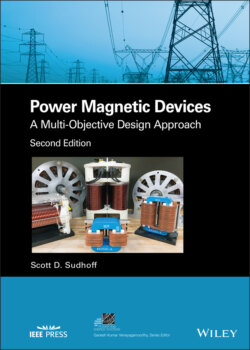Читать книгу Power Magnetic Devices - Scott D. Sudhoff - Страница 3
List of Tables
Оглавление1 Chapter 1Table 1.1 Newton’s Method ResultsTable 1.2 Pseudo‐Code for Mating, Crossover, Segregation, and MutationTable 1.3 Example of Real‐Coded Genetic Algorithm EvolutionTable 1.4 Linear Scaling MethodsTable 1.5 Pseudo‐Code for Kung’s MethodTable 1.6 Approach for Treating ConstraintsTable 1.7 Domain of Design Parameters
2 Chapter 2Table 2.1 Permeability Function ParametersTable 2.2 Nodal Analysis Formulation Algorithm (NAFA)Table 2.3 Branch List for Nodal AnalysisTable 2.4 Mesh Analysis Formulation Algorithm (MAFA)Table 2.5 Branch List for Mesh AnalysisTable 2.6 Nonlinear MEC Solution AlgorithmTable 2.7 Selected Permanent Magnet Properties
3 Chapter 3Table 3.1 Calculation of Fitness FunctionTable 3.2 Inductor SpecificationsTable 3.3 Design SpaceTable 3.4 Design 50 Data
4 Chapter 5Table 5.1 Calculation of Fitness FunctionTable 5.2 Electromagnet SpecificationsTable 5.3 Design SpaceTable 5.4 Design 250 Data
5 Chapter 6Table 6.1 Aluminum Alloy Test Samples
6 Chapter 7Table 7.1 Core and Clearance DimensionsTable 7.2 Winding ParametersTable 7.3 Pseudo‐code for Calculation of the Fitness FunctionTable 7.4 Pseudo‐code for Check of Constraints Satisfied Against ImposedTable 7.5 Transformer SpecificationsTable 7.6 Transformer Fixed ParametersTable 7.7 Design SpaceTable 7.8 Design 100 ParametersTable 7.9 Electrical ParametersTable 7.10 Operating Point Performance
7 Chapter 9Table 9.1 Pseudo‐Code for Calculation of the Fitness FunctionTable 9.2 Pseudo‐Code for Check of Constraints Satisfied Against ImposedTable 9.3 Design SpecificationsTable 9.4 Parameter RangesTable 9.5 Machine Design 38 from Pareto‐Optimal Front
8 Chapter 10Table 10.1 Thermal Nodal Analysis Formulation AlgorithmTable 10.2 Thermal Resistances to AmbientTable 10.3 Electrothermal Analysis AlgorithmTable 10.4 Electromagnet Thermal ParametersTable 10.5 Calculation of Fitness FunctionTable 10.6 Thermal ConductivitiesTable 10.7 Design 65 Data
9 Chapter 12Table 12.1 Parameter Domain
10 Chapter 13Table 13.1 Sample Semiconductor ParametersTable 13.2 Inductor Metamodel Parameters (UI‐Core, P‐Ferrite)Table 13.3 Buck Converter Specifications and A Priori Design ChoicesTable 13.4 Buck Converter Design SpaceTable 13.5 Design 100
11 Chapter 14Table 14.1 Case Study Operating Point DataTable 14.2 Three‐Phase I‐Core Inductor SpecificationsTable 14.3 Three‐Phase I‐Core Inductor Design SpaceTable 14.4 Design 100
12 Chapter 15Table 15.1 UR‐Core Common‐Mode Inductor SpecificationsTable 15.2 UR‐Core Three‐Phase Inductor Design SpaceTable 15.3 Design 75
13 Chapter 16Table 16.1 Domain list for Figure 16.4Table 16.2 Node list for Figure 16.4Table 16.3 Basis function coefficients
14 Appendix ATable A.1 Conductor DataTable A.2 American Wire Gauge Wire Diameters
15 Appendix BTable B.1 Ferrite Mass Density DataTable B.2 Ferrite μ>B() DataTable B.3 Ferrite MSE Parameters (Bb = 1T, fb = 1 Hz)
16 Appendix CTable C.1 Silicon Steel DataTable C.2 Silicon Steel μB() DataTable C.3 Silicon Steel MSE Parameters (Bb = 1T, fb = 1 Hz)
17 Appendix DTable D.1 Selected Magnet Data
